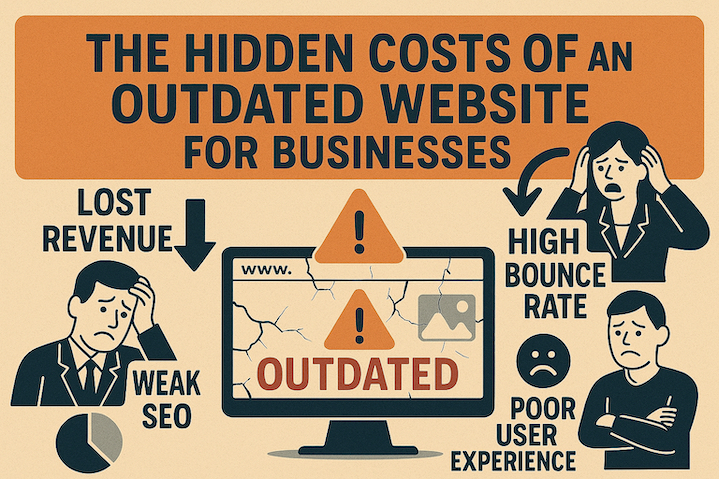In today’s digital landscape, your website is more than just an online presence—it’s a revenue-driving asset. Yet, many businesses overlook the hidden costs of an outdated site. From security vulnerabilities to lost sales and operational inefficiencies, an under performing website quietly drains profits.
A slow, clunky, or difficult-to-navigate site doesn’t just push potential customers toward competitors—it also creates internal roadblocks, making everyday tasks more time-consuming. Without modern integrations and a seamless user experience, frustration rises, conversions drop, and growth stalls.
This article uncovers the hidden expenses of an outdated website and how neglecting updates could be costing your business more than you realize. If your site isn’t optimized for today’s users, it’s time to stop the revenue leak.

1. Lost Revenue from Poor User Experience
An underperforming website isn’t just an inconvenience—it’s a revenue leak. Every second of slow load time, confusing layout, and missed integration means lost customers.
Slow Load Times = Lower Conversions
- A slow website significantly reduces engagement and conversions.
- Google reports that a one-second delay in page load time can decrease conversions by 7%. (Business Dasher)
- 53% of users abandon a site that takes more than three seconds to load. (Sweor)
Frustrating Navigation Limits Revenue
- 68% of B2B websites lack cross-sell and upsell features. (Statista)
- Only 50% offer quick reordering and clear fulfillment messaging.
- A poorly designed website frustrates users, limits revenue potential, and causes businesses to miss out on additional sales opportunities and a higher Average Order Value (AOV).
Poor Mobile Experience Drives Users Away
- As of 2025, mobile devices account for 62.69% of global web traffic. (Soax)
- 57% of users won’t recommend a business with a poorly designed mobile site. (WPBeginner)
- If your website isn’t mobile-friendly, you’re turning away potential customers before they even engage with your business.
- Google prioritizes mobile-first indexing, meaning an unresponsive website ranks lower in search results. (Rogue Wave Marketing)
Poor UX Increases Cart Abandonment
- A frustrating checkout process is a major cause of lost revenue.
- The average cart abandonment rate is just under 70%, according to the Baymard Institute. (Baymard Institute)
- 50% of abandoned carts are directly due to poor user experience. (Baymard Institute)
- 24% abandoned because the site required account creation. (Tidio)
- 17% found the checkout process too long or complicated. (Baymard Institute)
- 18% didn’t trust the site with their credit card information. (Tidio)
- 16% couldn’t see the total order cost upfront. (Hotjar)
- 13% left due to website errors or crashes. (Baymard Institute)
2. Decreased Search Engine Rankings (SEO Penalties)
Search engines prioritize fast, secure, and user-friendly websites. An outdated site that fails to meet these standards suffers in rankings, leading to decreased organic traffic and lost customers.
Poor SEO = Lower Visibility
- Websites that lack modern SEO best practices—such as mobile responsiveness and structured data—struggle to rank well in search results. This makes it harder for potential customers to find you, pushing them toward competitors with better-optimized websites.
- 96.55% of all web pages receive zero search traffic from Google. (Ahrefs)
- Only 0.63% of Google users click on results from the second page. (Backlinko)
SEO Decay & Lack of Fresh Content
- An outdated website isn’t just visually unappealing—it gradually loses visibility in search results due to SEO decay, as Google prioritizes regularly updated, high-quality content.
- Only 5.7% of pages will rank in the top 10 search results within a year of publication. This means that even new content struggles to rank—so an outdated site with old, unoptimized content is at an even greater disadvantage. (Ahrefs)
- The average first-page result on Google consists of 1,447 words, meaning outdated, thin content lacks the depth needed to compete for top rankings. (Search Engine Journal)
Mobile-First Indexing & Core Web Vitals
- Google’s Mobile-First Indexing prioritizes mobile-optimized sites, meaning non-mobile-friendly websites struggle to rank, especially against optimized competitors.
- Google considers Core Web Vitals—including mobile responsiveness and page speed—as key ranking factors. (Google)
- Mobile-first indexing became the default for new sites in 2019, and Google now crawls the mobile version of a site first. (Google)
3. Higher Maintenance and Security Risks
An outdated website is a hacker’s playground. Neglecting security updates leaves your business vulnerable to cyber threats and data breaches, risking sensitive information and your company’s reputation.
Security Vulnerabilities
- Older websites often run on outdated software, plugins, or frameworks, making them easy targets for cybercriminals. Hackers exploit these weaknesses to launch ransomware attacks and other cyber threats.
- Data Breaches and Identity Theft – A lack of security patches exposes customer data, increasing the risk of breaches. In 2024, the global average cost of a data breach reached $4.88 million—a 10% increase over the previous year. (Enzoic)
- Loss of customer trust—85% of users avoid sites flagged as “Not Secure”. (Global Sign)
- Legal and Financial Repercussions – Non-compliance with regulations like GDPR, CCPA, and HIPAA can result in heavy fines. Companies that fail to protect user data risk lawsuits and financial losses.
Increased Maintenance Costs
- Maintaining an outdated website leads to frequent bug fixes, security patches, and compatibility issues, increasing operational costs.
- Recurring Fixes – Companies often spend more on temporary fixes than they would on a strategic website redesign.
- Developer Dependence – Outdated websites sometimes require custom fixes from developers, leading to higher labor costs.
4. Wasting Advertising Budget
An outdated website drains your marketing budget by failing to convert visitors into leads or customers. When your landing pages are misaligned with your ads or filled with stale content, they weaken your advertising campaigns, lower conversion rates, and reduce your return on investment (ROI). Users clicking on ads expect a seamless experience—If they land on a page that doesn’t match their expectations, they will leave immediately.
How an Outdated Website Wastes Ad Spend
- Reduced Conversion Rates – Outdated landing pages often lead to lower conversion rates, wasting advertising dollars. (Webstacks)
- High Bounce Rates – Visitors leave instantly if your page is slow, poorly designed, or lacks relevant content, meaning you pay for clicks that never convert.
- Low Conversion Rates – Missing clear CTAs, mobile optimization, and a modern UX/UI makes it harder to turn visitors into paying customers.
- Poor Landing Page Experience – Google and other ad platforms rank landing pages based on relevance and usability. If your page is outdated, your ads receive lower Quality Scores, making them more expensive.
- Increased Cost-Per-Click (CPC) – A low Quality Score drives up CPC, depleting your ad budget faster while delivering fewer results.
- Lost Mobile Traffic – Mobile searches dominate paid search traffic, but if your website isn’t mobile-friendly, you’re missing a significant portion of potential conversions.
- Slow Page Load Speed – A 1-second delay in load time can reduce conversions by up to 20%, meaning you pay for visitors who abandon your site. (Lunio)
- SEO Conflicts with PPC – An outdated site often has poor SEO, forcing you to rely more on expensive paid traffic instead of free organic search visibility.
- Lower Quality Scores – Google prioritizes relevant and up-to-date content. An outdated site, leads to higher ad costs and lower ad rankings. (Webstacks)
5. Loss of Brand Credibility and Trust
First impressions matter—whether meeting someone in person or visiting a website for the first time. Just as people assess trustworthiness based on appearance and demeanor, users judge a brand’s credibility within milliseconds of landing on a site. Colors, typography, and layout shape user trust. People associate clean, modern design with quality and reliability. If a website is dated, visitors may question the business’s relevance and assume it is unreliable.
Modern website design follows the same trust-building principles found in human interactions: visual symbolism, impression management, and cognitive biases. A well-structured, up-to-date site signals professionalism, while a neglected one raises doubts.
Negative First Impressions
- First impressions are 94% design-related. (Research Gate)
- 75% of consumers judge a business’s credibility based on website design. (Business Dasher)
- If a website is outdated, users immediately question its reliability.
- 38% of users will stop engaging with a website if the layout is unattractive. (Forbes)
- 88% of online consumers are less likely to return to a website after a bad user experience. (Think With Google)
6. Reduced Employee Efficiency
An outdated website doesn’t just impact customers—it slows down employees too.
Workflow Bottlenecks
- Lack of automation for sales, customer service, and content management forces employees to perform manual tasks that could be streamlined.
- Inefficient internal systems lead to wasted time and decreased productivity.
Limited Scalability
- A website that can’t support new features, handle increased traffic, or integrate with modern business tools stifles growth.
7. Competitive Disadvantage
A poor website hands your competitors an easy win.
Losing Customers to Competitors
- Users expect a seamless online experience—if they don’t get it, they leave.
- 88% of users won’t return after a bad website experience. (Sweor)
Eroding Market Share
Digital-savvy businesses continuously refine their online presence, leaving outdated competitors behind.
Conclusion: Is Your Website Helping or Hurting Your Business?
The hidden costs of an outdated website extend far beyond aesthetics. They impact revenue, security, SEO, marketing effectiveness, brand credibility, and employee productivity. Ignoring these issues costs businesses more in lost opportunities than the investment required for a website redesign.
📢 If your website isn’t driving results, it’s time for a change.
💡 Let’s fix that. Contact us today for a free consultation on how to future-proof your business online. 🚀

